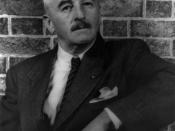It has been said that love is truest in death. The short story "A Rose For Emily", by William Faulkner, reflects the meaning of this phrase, though in a slightly psychotic way. Faulkner leaves hints of his twisted ending throughout the story. The footsteps lead the reader to the grave and include a container of arsenic, a disappearing Yankee man and the beautiful, but dark way Faulkner unweaves his yarn.
Entering the drug store Miss Emily asks for poison, the stronger the better. Under the druggist's questioning, Miss Emily implies that the arsenic was meant for her rat problem (Faulkner III). Miss Emily has been known to be a lonely lady so the gossip around town predicts that she will soon be a victim of suicide. The story continues and the arsenic becomes momentarily forgotten as the predictions of impending self-death pass and Miss Emily continues to live her solitary, quiet life.
The arsenic is a planted hint to what will come as Miss Emily's secret is found out in the end of the story. The arsenic was used to kill Miss Emily's beau, Homer Barron.
Miss Emily had an affair with Homer Barron, a Yankee who came to town with a crew of road workers. The rumors around town were that Homer was not the marrying type; some cackle-eyed old ladies mused that he liked men. Homer was not a likely marriage candidate for Miss Emily. He was a rough man, a laborer, and Miss Emily was from a refined, traditional, wealthy family. At the age of thirty she had little chance to be picky however, since her father had very successfully chased away any possible suitors long ago. Just as the town gossips had decided that Miss Emily and Homer really were to be...


